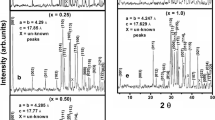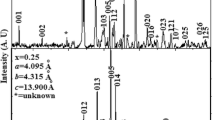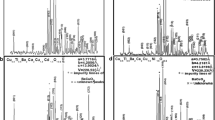Abstract
We have synthesized (Cu0.5Tl0.5)Ba2Ca3(Cu4−x Ti x )O12−δ (x = 0, 0.25, 0.50, 0.75, 1.0) superconductors by two-step solid-state reaction method at 880 °C. The a-axis length of tetragonal unit cell increases, whereas the c-axis decreases with doping of Ti in the final compound revealed by X-ray diffraction measurements. Moreover, the magnitude of superconductivity suppresses with increased Ti doping. The Fourier transform infrared spectrometer (FTIR) absorption measurements have shown that the peak position of the apical oxygen modes at 480 and 540 cm −1 remains unchanged, whereas the CuO2/TiO2 planar oxygen modes is softened with increased Ti doping. We explained the softening of planar oxygen mode to be arising due to the difference in the atomic masses of Ti (47.90 amu) and Cu (63.54 amu) atoms. The suppression of superconductivity magnitude is suggested to be originating from an-harmonic oscillations induced by doped Ti atoms which in turn suppress the density of phonon population. These studies show the importance of density of phonon population in mechanism of high- T c superconductivity and hence the electron-phonon interactions. The excess conductivity analyses (FIC) of conductivity data of these samples have shown that with increased Ti doping, the mean field critical temperature T cmf is shifted to lower temperatures. The increase in the coherence length along the c-axis, interlayer coupling, and the Fermi velocity is suggested to be arising from the decrease in the c-axes length. We attribute the suppression in B c, B c1, J c(0), and τ ϕ with Ti doping to the free energy difference between the normal and superconducting state. The idea of suppression in the density of phonon modes induced by Ti doping is supported by excess conductivity analyses.
Similar content being viewed by others
Avoid common mistakes on your manuscript.
1 Introduction
The superconductivity in oxides is confined in CuO2 planes, whereas the carriers are supplied by Cu0.5Tl0.5Ba2O4−δ charge reservoir layers [[1, 2], and references therein]. Copper atoms in the CuO2 planes where superconductivity lies are in the 3 d 9 state, which provide the skeleton of covalent bonding, and the metallic character arises from the delocalized 4 s 2 electrons [3, 4]. Since the wave function spread of 4 s 2 electrons is extended to many interatomic spacing, these compound show enough density of carriers at room temperature and hence the metallic behavior from room temperature down to onset of superconductivity. The possibility of existence of electron-phonon interaction in oxide superconductors is quite possible; however, the oxygen isotope effect measurements have ruled out any role of oxygen atoms of such mechanism. This shows that any role of the hard phonons in mechanism of high- T c superconductivity is minimal. In order to look into the possibility of soft phonons in the mechanism of high- T c superconductivity [5], we have doped the Ti at Cu sites in CuO2 planes of (Cu0.5Tl0.5)Ba2Ca3(Cu4−x Ti x )O12−δ (x = 0, 0.25, 0.50, 0.75, 1.0) superconductors. The substitution of this atom at the copper site will be helpful in understanding the role of phonon interaction in the mechanism of high-temperature superconductivity [6–8]. Titanium atom has ground state electronic configuration 3 d 2⋅ 4 s 2 and atomic mass of the Ti (47.9 amu) which is smaller than the Cu (63.5 4amu) atoms. Due to this difference in masses, it is likely that doped Ti atoms may induce an-harmonic oscillations which will suppress the density of phonon in CuO2/TiO2 planes. These experiments will be helpful in determining the pivotal role of electron-phonon interactions in the mechanism of high- T c superconductivity.
2 Experimental
(Cu0.5Tl0.5)Ba2Ca3(Cu4−x Ti x )O12−δ (x = 0, 0.25, 0.50, 0.75, 1.0) samples were synthesized by two-step solid-state reaction method. In the first stage, Cu0.5Ba2Ca3(Cu4−x Ti x )O12−δ (x = 0, 0.25, 0.50, 0.75, 1.0) precursor material was synthesized mixing weighted amounts of TiO2, Ba(NO3)2, Ca(NO3)2⋅ 4H2O, and Cu(CN) in a quartz mortar pestle followed by firing at 880 °C in a quartz boat for 24 h. These samples were furnace cooled to room temperature and ground again for an hour and again fired at 880 °C in an alumina boat for 24 h. These samples were furnace cooled to room temperature after each heat treatment. The precursor material was again ground for about an hour and mixed with Tl2O3 to give (Cu0.5Tl0.5)Ba2Ca3(Cu4−x Ti x )O12−δ (x = 0, 0.25, 0.50, 0.75, 1.0) as final reactants composition and pelletized under 3.8 tons/cm 2. The pellets were then wrapped in a gold capsule and annealed for about 18 min at 880 °C and then quenched to room temperature after the heat treatment. The superconductivity characteristics of the samples were measured by resistivity, AC susceptibility, and Fourier transform infrared spectroscopic measurements. The Fourier transform infrared spectroscopic (FTIR) measurements absorption measurements were carried out by using Nicolet 5700 Fourier Transform Infrared Spectrometer (FTIR) in 400–700 cm −1 wave number range. The crystal structure of the samples was measured by X-ray diffraction scan using Bruker DX 8 Focus employing CuK α radiations of wavelength 1.54056 Å. The cell parameters were determined by check cell computer refinement program.
3 Results and Discussion
3.1 (a) Ti-Doped (Cu0.5Tl0.5)Ba2Ca3(Cu4−x Ti x ) O12−δ (x = 0, 0.25, 0.50, 0.75, 1.0) Samples
The X-ray diffraction scans of (Cu0.5Tl0.5)Ba2Ca3(Cu4−x Ti x )O12−δ (x = 0, 0.25, 0.50, 0.75, 1.0) samples are shown in Fig. 1a–e. The planar reflections are best fitted to the tetragonal crystal structure following P4/MMM space group. The c-axis length suppresses, whereas the a-axis length increases with Ti doping (Fig. 2). The resistivity versus temperature measurements of as-prepared (Cu0.5Tl0.5)Ba2Ca3(Cu4−x Ti x )O12−δ (x = 0, 0.25, 0.50, 0.75, 1.0) samples are displayed in Fig. 3. These samples have shown room temperature resistivity around 0.041, 0.231, 0.111, 0.186, and 0.110 Ω cm, respectively. The smaller room temperature resistivity values are an indication of lower density of defects in the final compounds. The metallic variation of resistivity from room temperature down to onset temperature of superconductivity is typical feature of these samples. These samples have shown onset of superconductivity around 124.6, 118.7, 117.7, 116.1, and 120 K and T c(R = 0) at 108.4, 100.1, 97, 94.4, and 99 K, respectively. AC magnetic susceptibility measurements of (Cu0.5Tl0.5)Ba2Ca3(Cu4−x Ti x )O12−δ (x = 0, 0.25, 0.50, 0.75, 1.0) samples are displayed in Fig. 4. It can be seen from this figure that the magnitude of the superconductivity is suppressed with Ti doping in the final compound. The onset of superconductivity is observed around 105.6, 114.3, 103.7, 115.2, and 102.4 K, respectively.
The FTIR absorption measurements of (Cu0.5Tl0.5)Ba2Ca3(Cu4−x Ti x )O12−δ (x = 0, 0.25, 0.50, 0.75, 1.0) samples are displayed in Fig. 5. Three absorption bands around 484, 538–539, and 598–582 cm −1 can be seen in these spectra. The former two modes are related to the vibrations related to apical oxygen atoms, whereas the third one is associated with the vibrations of planar oxygen atoms [9, 10]. The peak position of the apical oxygen modes is not appreciably changed, but the planar oxygen mode is systematically softened with increased Ti doping. Planar oxygen mode in (Cu0.5Tl0.5)Ba2Ca3(Cu4−x Ti x )O12−δ (x = 0, 0.25, 0.50, 0.75, 1.0) samples is observed around 598, 594, 589, 586, and 582 cm −1, respectively. The most likely reason for the softening of planar oxygen mode is the smaller mass of the doped Ti atoms. The atomic mass of Ti (47.90 amu) is smaller than Cu (63.54 amu) atoms that promotes an increase in the bond length of planar oxygen atoms and make them oscillate at the lower wavenumbers.
3.2 (b) Excess Conductivity Analyses (Cu0.5Tl0.5)Ba2Ca3(Cu4−x Ti x )O12−δ (x = 0, 0.25, 0.50, 0.75, 1.0) Samples
The temperature dependence of conductivity around T c and beyond it follows the relationship of the form Δσ (T) = Δσ RT ε −λD. The analyses of excess conductivity Δσ (T) are done by converting this relationship into equation which identical to the Arrhenius relation:
Here, the \(\varepsilon =\left [ {\frac {T-T_{\mathrm {c}}^{\text {mf}}}{T_{\mathrm {c}}^{\text {mf}}}} \right ]\) is the reduced temperature and the λD is dimensional exponent.
The mean field critical temperature \(T_{\mathrm {c}}^{\text {mf}}\) is determined from the point of inflection of the temperature derivative of resistivity (d ρ/dT). Depending upon the values of λD, the dimensional exponent explains various thermally activated processes in three, two, and one dimensions. The λD value around 0.33 corresponds to critical regime, 0.5 three-dimensional conductivity (3D), 1.0 two-dimensional (2D), and 2.0 for zero-dimensional (0D) conductivity, respectively [11–14]. At the junction of various thermally activated processes, three crossover temperatures are found, i.e., T G, T 3D−2D, and T 2D−0D. The T G is the crossover temperature of Ginzburg-Landau regime with three-dimensional conductivity regimes, the T 3D−2D is the crossover temperature of three-dimensional conductivity regime with two-dimensional conductivity regimes, and the T 2D−0D is the crossover temperature of two-dimensional conductivity regime with zero-dimensional conductivity regimes. Various crossover temperatures derived from the log plot of the excess conductivity versus the reduced temperature are mentioned in the Fig. 6 a–e and Table 1. The values of various exponents such as, λcr, λ3D, λ2D, and λ0D are given in Table 2.
The Aslamazov-Larkin theory [14] is used for the excess conductivity analysis of thin film samples, whereas for the polycrystalline samples the Lawrence and Doniach (LD) model is employed [15]. The following is the expression of the Lawrence and Doniach (LD) model:
In this expression, the J = [2 ξ c(0)/d] 2 is interlayer coupling, d is the thickness of superconducting layers (∼ 18 Å in present case), and the ξ c(0) is coherence length along the c-axis. The excess conductivity analyses of conductivity data of (Cu0.5Tl0.5)Ba2Ca3(Cu4−x Ti x )O12−δ (x = 0, 0.25, 0.50, 0.75, 1.0) samples have shown that the coherence length along the c-axis, the Fermi velocity of the carriers and the interlayer coupling J increase with the doping of Ti in the final compounds. The enhancement in the value of these parameters is most likely associated with the decrease in the c-axis length with doping of Ti (see Table 2).
The Ginzburg number N G is determined from the crossover temperature T G of critical and three-dimensional conductivity regimes. By employing N G and the Ginzburg-Landau theory, following important superconducting parameters are evaluated by using the equations of the following forms [15–17]:
The κ = λ/ ξ, B c, B c1, B c2, J c, and τ ϕ are the Ginzburg-Landau (GL) parameter, thermodynamic critical field, the lower critical field, the upper critical field, and the critical current density, respectively.
Using the phase relaxation time of the Cooper pairs τ ϕ and the coupling constant \(\lambda \lambda =\frac {\hslash \tau _{\varphi }^{-1}}{2\pi k_{\mathrm {B}} T}\), the Fermi velocity of the carriers V F and the energy E required to break up the Cooper pairs are determined by using equations of the following form:
The proportionality coefficient K used in the above equation (9) is 0.12 [18]. The values of parameters such as B c, B c1, J c(0), and τ ϕ got decreased with increase in Ti doping. The parameters B c1 and J c(0) depend on B c that in turn depend on the free energy difference between the normal and superconducting state. The suppression in the values of these parameters suggests that superconductivity volume fraction suppresses with the doping of Ti in the final compound. This also support our thesis that incorporation of Ti in the CuO2 planes induces an-harmonic oscillation that suppresses the density of phonons and hence the superconductivity. These studies strongly suggest that role of electron-phonon interactions is essential in the mechanism of high- T c superconductivity. Moreover, since the superconductivity is being influenced by the doping of Ti at the Cu sites, this shows that the role of soft phonon is essential for the high- T c superconductivity.
4 Conclusions
(Cu0.5Tl0.5)Ba2Ca3(Cu4−x Ti x )O12−δ (x = 0, 0.25, 0.50, 0.75, 1.0) superconductors are prepared by two-step solid-state reaction method at 880 °C. The samples are characterized by X-ray diffraction, resistivity, AC susceptibility, and FTIR absorption measurements. These samples have shown tetragonal crystal structure with the a-axis length increasing, whereas the c-axis decreasing with increased Ti doping. The magnitude of superconductivity also suppresses with increase in Ti doping. FTIR absorption measurements of (Cu0.5Tl0.5)Ba2Ca3(Cu4−x Ti x )O12−δ (x = 0, 0.25, 0.50, 0.75, 1.0) samples have shown that the peak position of the apical oxygen modes at 480 and 540 cm −1 stays at the same position, whereas the CuO2/TiO2 planar oxygen modes is softened with increased Ti doping. The origin of softening of planar oxygen mode lies in decrease mass of doped the Ti (47.90 amu) atoms relative to the Cu (63.54 amu) atoms that results in increase of the bond length of the a-axis, and hence, these modes are softened. A possible correlation of suppression of superconductivity is attributed to the presence of atoms of different masses in CuO2/TiO2 planes which produce an-harmonic oscillations and hence suppress the density of phonon population. The phonons of harmonic oscillation with wave vector q and the an-harmonic oscillation with wave vector \(q^{\prime }\) produces a new phonon with wave vector q that do not contribute in the Cooper pair formation. It suppresses the density of essential phonon required for the Cooper pair formation and hence the superconductivity. These studies show the essential role of electron-phonon interactions in the mechanism of high- T c superconductivity. Excess conductivity analyses (FIC) of these samples have shown that the transition width increases and the mean field critical temperature T cmf is shifted to lower values with increased Ti doping. The increase in the coherence length along the c-axis, interlayer coupling, and the Fermi velocity of the carriers with Ti doping is reminiscence of decreased the c-axes length. The values of B c, B c1, J c(0), and τ ϕ are, however, suppressed with increased Ti doping. Since the B c determines the free energy difference between the normal and superconducting state, decreased values of it shows that superconducting volume fraction decreases with increased Ti doping. The excess conductivity analyses also support this thesis that density of phonon population suppresses with the Ti doping that result in suppression of the population of superconducting electrons, showing the essential role of electron-phonon interaction in the mechanism of high- T c superconductivity. These studies have explicitly shown that soft phonon play an essential role in the high- T c superconductivity.
References
Nawazish, A., Khan, A., Javaid, A.A., Khurran, N.H.: Phys. C 425, 90 (2005)
Jergel, M., Conde Gallardo, A., Falcony Guajardo, C., Strbik, V.: upercond. Sci. Technol. 9, 427 (1996)
Ibach, H., Lüth, H.: Solid-state physics: an introduction to theory and experiment. Springer (1993)
Christman, J.R.: Fundamentals of Solid Statem, 1st, p. 215. Wiley (1987)
Khan, N.A., Arif, M.: Physica C 488, 35 (2013)
Mumtaz, M., Khan, N.A., Nawaz, R.: J. Supercond. Nov. Magn. 23, 565–569 (2010)
Khan, N. A., Rahim, M.: J. Alloys Compd. 481, 81 (2009)
Rahim, M., Khan, N.A.: J. Alloys Compd. 513, 55 (2011)
Prade, J., Kulkarni, A.D., De Welte, F.W.: Phys. Rev. B 39, 2771 (1989)
Kulkarni, A.D., De Welte, F.W., Prade, J., Schroder, U., Kress, W.: Phys. Rev. B 41, 6409 (1990)
Sato, T., Nakane, H., Mori, N., Yoshizawa, S.: Phys. C 344, 244 (2003)
Ghosh, A.K., Bandyopadhyay, S.K., Barat, P., Sen, P., Basu, A.N.: Phys. C 264, 255 (1996)
Manmeet Kaur, R., Srinibasan, G.K., Mehta, D., Kanjilal, R., Pinto, S.B., Ogale, S., Mohan, V.G.: Phys. C 443, 61 (2006)
Aslamazov, L.G., Larkin, A.L.: Phys. Lett. A 26, 238 (1968)
Lawrence, W.E., Doniach, S.: In: Kanda, E. (ed.) Proceedings of the Twelfth International Conference on Low Temperature Physics, p. 361, Keigaku, Tokyo (1971)
Abu Aly, A.I., Ibrahim, I.H., Awad, R.A., El-Harizy, A.: J. Supercond. Nov. Magn. 23, 1325 (2010)
Rojas Sarmiento, M.P., Uribe Laverde, M.A., Vera Lopez, E., Landinez Tellez, D.A., Roa-Rojas, J.: Phys. B 398, 360 (2007)
Ben Azzouz, F., Zouaoui, M., Annabi, M., Ben Salem, M.: Sol. Stat. Phys. C 3, 3048 (2006)
Solovjov, A.L., Dmitriev, V.M., Habermeier, H.-U.: Phys. Rev. B 55, 8551 (1997)
Author information
Authors and Affiliations
Corresponding author
Rights and permissions
About this article
Cite this article
Khan, N.A., Abbas, S.Q. & Khan, M.N. Significance of Phonon Modes and Excess Conductivity of (Cu0.5Tl0.5)Ba2Ca3(Cu4−x Ti x )O12−δ (x = 0, 0.25, 0.50, 0.75, 1.0) Superconductors. J Supercond Nov Magn 28, 2009–2015 (2015). https://doi.org/10.1007/s10948-015-2998-5
Received:
Accepted:
Published:
Issue Date:
DOI: https://doi.org/10.1007/s10948-015-2998-5










